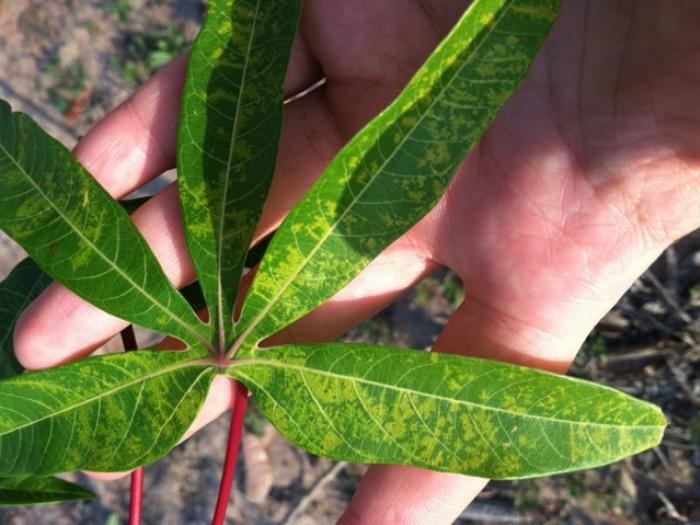An international partnership launched at the BecA-ILRI Hub brought together scientists from East Africa and US to examine the evolution of the Cassava mosaic virus (CMV) as an approach to tackling the Cassava mosaic disease (CMD).
CMD is responsible for between 12 and 23 million tonnes crop yield losses in Africa where cassava is staple food for over 250 million people. Cassava mosaic virus, like other viruses, has an exceptionally high mutation rate, rapid replication and recombination. This characteristic has enabled it to adapt to different environmental conditions over time and break plant resistance, confounding efforts to combat CMD.
The project is among one of the most detailed studies of virus evolution ever conducted and is expected to make groundbreaking discoveries relevant to other viruses with significant economic and health impacts like the dengue virus. The partnership around the Cassava virus evolution research is an example of north-south and south-south collaborations fostered by the BecA-ILRI Hub, providing training and capacity building for African researchers and enabling early career US scientists to work with researchers at the BecA-ILRI Hub and Mikocheni Agricultural Research Institute (Tanzania).
Entomologists George Kennedy (NCSU) and Alana Jacobson (AU) spent a month at the BecA-ILRI Hub to help get the research off the ground. The project leader, Linda Hanley-Bowdoin (NCSU) also visited to the BecA-ILRI Hub to mentor and monitor research progress.
From mid-2016, post-doctoral scientists Gabriela Chavez from Auburn University (AU) and William Sharpee from North Carolina State University (NCSU) have been working on the project alongside outstanding scientists in Africa, including Tanzanian, Joseph Ndunguru who has spent many years in cassava research. They work under the mentorship of BecA-ILRI Hub postdoctoral scientist Josiah Mutuku and director Appolinaire Djikeng.
From USA to Africa: Tracking cassava viruses
By Gabriela Chavez, postdoctoral fellow, Auburn University
I joined the Cassava Virus Evolution Project to study the most economically important disease in cassava in Africa. Like me, the cassava is indigenous to South America, but is now widely cultivated and adopted in Africa where it became one of the major crops for human consumption.
Cassava is a fascinating crop that is able to grow under drought conditions, high temperature, and poor soil conditions. However, its production in Africa is severely limited by viral diseases. The begomoviruses that cause CMD have a long evolutionary history in Africa, including the recent pandemic that spread across Sub-Saharan Africa in the 1990s and 2000s.
At the BecA-ILRI Hub, I am studying how the whitefly influences the evolution of Cassava mosaic begomoviruses. Together with colleagues, I am analyzing the genetic makeup of a colony of whiteflies collected from the western part of Kenya in Kisumu and Lake Victoria surroundings. This is a critical component of the project because whiteflies exhibit a very high rate of differences within the species.
Working in Africa has been a life-changing multicultural experience. I have learnt that Africa is not all about catastrophes or poor infrastructure highlighted in news, but that there is cutting-edge research and high-end technologies. I have also enjoyed the contemporary Kenyan music in English, Swahili and various local languages with intricate melodies that borrow from different styles of music from around the globe. I am also impressed with Kenyans’ ambitions and their spirit of entrepreneurship.
Cassava, flies and viruses: studying the role of whiteflies in cassava disease at the BecA-ILRI Hub
By William Sharpee, postdoctoral fellow, North Carolina State University
I came to the BecA-ILRI Hub in August to work on a project funded by the NSF-PIRE program to analyze the evolution of the viruses that cause CMD. The purpose of this project is to understand how African cassava mosaic virus (ACMV) and East African cassava mosaic virus (EACMV), the causal agents of CMD, evolve during vegetative propagation of infected cassava plants versus being transmitted via whiteflies. It is our goal to understand how these viruses evolve in order to develop strategies that will hinder the development of more virulent strains and thus prevent future outbreaks of CMD.
When I first arrived in Kenya, I travelled to the shores of Lake Victoria in the western part of Kenya to collect whiteflies for the establishment of a colony at the BecA-ILRI Hub. This was a good opportunity to interact with local farmers and see the devastating effects that this disease has on cassava production in Kenya. Once the individual whiteflies were collected we set up a room dedicated to establishing a colony to be used in future experiments.
Because multiple species of whiteflies exist, my colleagues and I have focused our efforts on understanding the genetic make-up of the colony to ensure that we have a single species for our experiments. Additionally, we established procedures for the propagation and growth of cassava in the greenhouse. We continue to lay the groundwork for pilot experiments that will act as the basis for our future work.
I am excited to be a part of this project and the BecA-ILRI Hub community. I am grateful for everyone’s support and input and look forward to great discoveries in the future.
Established with funding from the National Science Foundation Partnerships for International Research and Education (NSF-PIRES), the Cassava evolution research project brings together scientists from Auburn University, North Carolina Agricultural and Technical State University, North Carolina State University and Rutgers University in US; the BecA-ILRI Hub, Kenya; and the Mikocheni Agricultural Research Institute (MARI) and NM-AIST, Tanzania.
